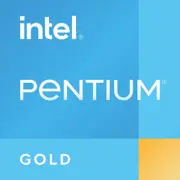Intel Pentium Gold G6505T

Intel Pentium Gold G6505T: Budget Processor for Basic Tasks in 2025
(April 2025)
Key Features: Architecture and Performance
The Intel Pentium Gold G6505T processor, released within the Comet Lake line (2020), remains relevant in 2025 due to its low power consumption and affordable price.
- Architecture and Process: 14nm technology (Intel’s 3rd Gen 14nm++), 2 cores, 4 threads (Hyper-Threading). Base frequency — 3.6 GHz (no Turbo Boost).
- Cache and Graphics: 4 MB L3 cache, integrated GPU Intel UHD Graphics 630 (base frequency 350 MHz, maximum — 1.05 GHz).
- TDP: 35 W — ideal for compact systems.
Key Features:
- Supports 4K via HDMI 1.4 and DisplayPort 1.2.
- Intel Quick Sync Video technology (video encoding acceleration) and AES-NI (data encryption).
- Compatible with Windows 11 and Linux distributions.
Performance:
In Cinebench R23 tests, the processor scores around ~2200 points (single-threaded — ~1000). For comparison: AMD Athlon 3000G (2/4) shows similar results but lags in energy efficiency.
Compatible Motherboards
Socket: LGA 1200.
Chipsets:
- H410/B460/H470: Budget choice for office PCs (H410 — from $60).
- Z490/Z590: For enthusiasts wanting to connect PCIe 4.0 NVMe (but the CPU does not support PCIe 4.0).
Recommendations:
- For a basic build: ASRock H410M-HDV ($65).
- For an upgrade: MSI B460M PRO-VDH WiFi ($90) with Wi-Fi 6 support.
Important: After 2023, many LGA 1200 boards have been discontinued but are available on the second-hand market. When purchasing new, check compatibility with BIOS version P4.20 and above.
Supported Memory
- Type: DDR4-2666 MHz (officially).
- Configurations: Up to 128 GB (2 channels, 2 slots on most boards).
Tips:
- Optimal amount: 8–16 GB (e.g., Crucial DDR4-2666 16GB Kit — $45).
- Avoid DDR5: The processor and LGA 1200 chipsets do not support the new standard.
Power Supplies: Calculation and Recommendations
With a TDP of 35 W, even a 300 W PSU will suffice, but it's important to consider peripherals:
- Without a discrete graphics card: EVGA 400W 80+ (≈$35).
- With a GTX 1650 level GPU: Thermaltake Smart 500W 80+ Bronze ($50).
Rule: For systems with Pentium Gold G6505T + GPU, allocate 150–200 W for the graphics card and 50–100 W for other components.
Pros and Cons
Pros:
- Energy efficiency: PCs based on this CPU can be built without active cooling.
- Price: The new processor costs $75–85 (as of April 2025).
- Integrated graphics: Suitable for 4K video and light gaming (CS:GO, Dota 2 on low settings).
Cons:
- 2 cores: Multitasking is limited (e.g., streaming on Twitch + gaming is not feasible).
- Outdated process: Ryzen 3 5300G (6nm) is 30% faster in multi-threaded tasks.
Use Cases
1. Office tasks: Working with documents, browsing (10+ tabs), Zoom conferences.
2. Multimedia: Streaming 4K video, Netflix, photo editing (Lightroom).
3. Light gaming: Minecraft, Genshin Impact (720p, low settings), Retro emulators.
Real Example:
A user built an HTPC (home theater PC) on Pentium G6505T + 8 GB RAM + 256 GB SSD. The system consumes 25 W in idle mode, runs Plex Media Server, and 4K HDR smoothly.
Comparison with Competitors
1. AMD Athlon 3000G ($60):
- Pros: Vega 3 graphics are stronger than UHD 630.
- Cons: No support for PCIe 3.0 x16.
2. Intel Celeron G5925 ($50):
- Pros: Cheaper.
- Cons: No Hyper-Threading, frequency 3.6 GHz.
3. Ryzen 3 5300G ($120):
- Pros: 4 cores/8 threads, Radeon Vega 6.
- Cons: Higher price and TDP (65 W).
Practical Assembly Tips
1. Case: Choose compact Mini-ITX (Cooler Master Elite 110 — $50).
2. Cooling: The stock cooler is sufficient, but for quiet operation — Noctua NH-L9i ($45).
3. Storage: An SSD is a must (Kingston A400 480GB — $35).
4. Network Options: Add a PCIe Wi-Fi card (TP-Link Archer TX50E — $40) if the motherboard lacks a module.
Assembly Mistakes:
- Installing DDR4-3200: The processor is limited to 2666 MHz.
- Buying an expensive motherboard: Z590 is overkill for this CPU.
Final Conclusion: Who is the Pentium Gold G6505T suitable for?
This processor is a choice for:
- Budget users: Building a PC for $250–350.
- Office workstations: Reliability and low power consumption.
- DIY enthusiasts: Creating quiet media centers or PC routers.
Why in 2025?
Despite its age, the G6505T remains one of the most affordable CPUs with 4K and Hyper-Threading support. If you don't need modern gaming or rendering, it offers an optimal balance of price and functionality.
Prices are current as of April 2025. They are for new devices in retail stores in the USA.
Basic
CPU Specifications
Memory Specifications
GPU Specifications
Miscellaneous
Benchmarks
Compared to Other CPU
Share in social media
Or Link To Us
<a href="https://cputronic.com/en/cpu/intel-pentium-gold-g6505t" target="_blank">Intel Pentium Gold G6505T</a>